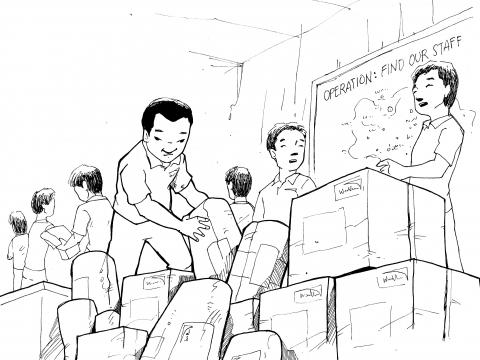Responding to the Pacific’s biggest disaster and preparing communities for the next

By Nini Tamasui, as told to Chloe Morrison, Illustration by James Dimanarig
I will never forget the sound of Cyclone Pam; the constant wind and the pouring rain. I never knew wind could be so fierce and damage so many things in just a few hours - but Cyclone Pam was unlike anything I’ve ever lived through - and I live in one of the most disaster prone countries in the world, Vanuatu. Here we are at risk of cyclones, tsunamis, earthquakes, floods and volcanic eruptions.
Cyclone Pam hit Port Vila at around midnight and though I couldn’t see anything, I could hear everything. At first all I could hear was nothing but wind, wind, wind and pouring rain. Then I could hear tress and tin roof flying around and smashing things. And as I was listening to destruction all around me, my own tin roof started to peel off and water came pouring into my house.
Cyclone Pam hit Port Vila at around midnight and though I couldn’t see anything, I could hear everything.
As morning slowly broke, I opened my door to see destruction all around my village. Iron roof sheets and trees were laying everywhere and many homes were badly damaged, but most importantly, everyone including my family was safe.
The week before Cyclone Pam, World Vision worked with communities to warn them about the cyclone and help them prepare by telling them to get water and food ready. We also had prepositioned items like hygiene kits and tools ready so that we could respond quickly.
At work, we immediately began Operation: Find Our Staff. Phone lines were down which meant we had to go out to villages to make sure people were okay. It was about a week before we could make contact with all of our staff throughout the country. It was a stressful time for everyone, because we were beginning to realise just how big our response would be.
Read part 5 of the humanitarian illustrated blog series - volunteering before and during a disaster.
I had only moved back to Port Vila, Vanuatu’s capital city three months before Cyclone Pam hit. Before I had been based on Tanna Island as the Area Programme Manager and nine days after Cyclone Pam I went back to Tanna to lead World Vision’s Tanna Response.
Flying over Tanna I was shocked. Normally when you fly over Tanna you see kilometres of green trees, but after the cyclone it was just brown, bare land. I was surprised to see that the wind didn’t just uproot tress, but some had snapped in half, left standing like bare twigs.
On Tanna, World Vision worked with the Provincial Disaster Management Committee and World Food Programme to deliver emergency food to communities in South, South-West and South-East Tanna.
We also delivered non-food items like kitchen sets, hygiene kits, and tarpaulins to thousands of affected families to help them recover.
While I hope Vanuatu will never have a cyclone like Pam again, we are living in one of the most vulnerable countries in the world to disasters and the biggest lesson I learnt was the importance of being prepared.
Even though our office on Tanna is the oldest building in the area, it was the only one that was undamaged because our team sandbagged the roof and nailed boards on the windows; newer buildings were destroyed.
Cyclone Pam taught us that we shouldn't wait and see how powerful a disaster will be to take every necessary step to be on the right side of the disaster and not the wrong side.
Fortunately because of the early warnings, many people were able to go to evacuation centres, meaning that even though it was a huge disaster, the death toll was low.
We’ve been working with communities to make sure that people are rebuilding safer and better so their homes aren’t just rebuilt, but that they’re rebuilt to withstand disasters. While we’re still responding to Cyclone Pam, we’re preparing communities for future disasters.
About the author | Nini Tamasui is World Vision Vanuatu’s Deputy Operations Manager and was World Vision’s Cyclone Pam Response Manager on Tanna.